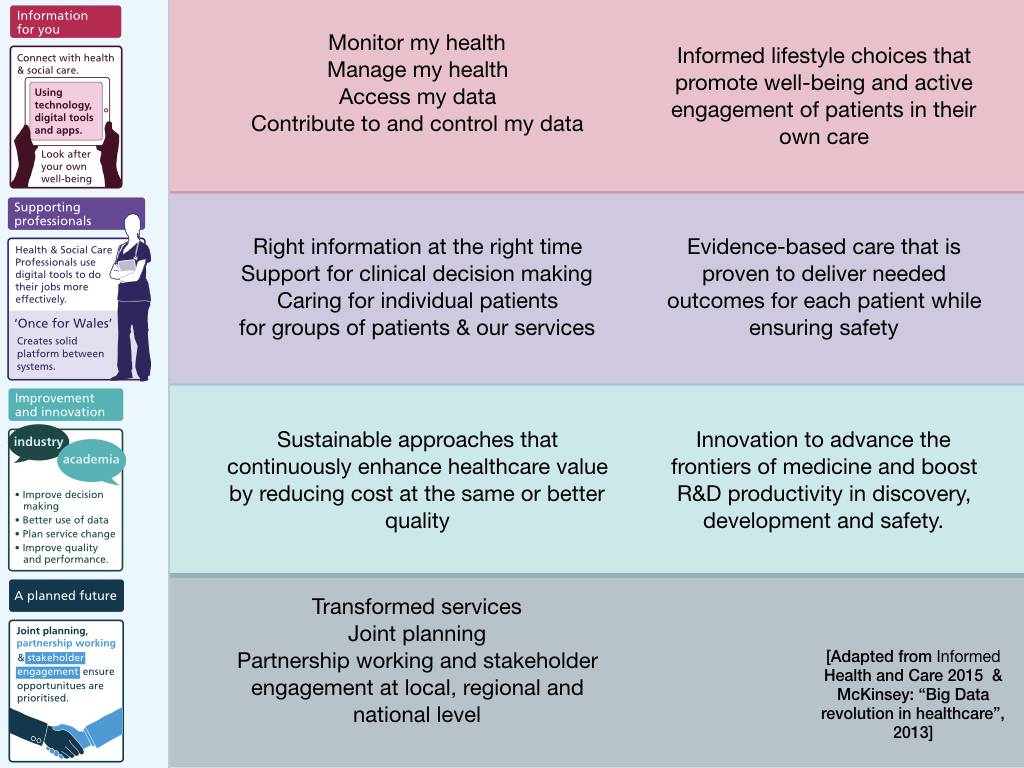The paradox of control: Enabling innovation
The Informed Health and Care Strategy, 2015 sets out a clear vision for Wales to use digital technology and online services to support and enable care. The strategy is divided into four workstreams:
- Information for you
- Supporting Professionals
- Improvement and Innovation
- A Planned Future

Delivery of this vision would result in Wales uniquely blending socialised universal prudent healthcare with modern state-of-the-art technology to provide a responsive, fair and quality service.
But we have to question whether we have the current organisational and governance structures within NHS Wales to most effectively implement this strategy? Historically, there has been a lack of pace in the delivery of individual projects that, together, should be incrementally fulfilling important components of the wider vision. Together, those individual projects should be stepping stones on which we deliver that vision.
Wales is a unique place to deliver an effective healthcare information technology strategy given its size and our lack of purchaser-provider split and as a result, technology should be being used to effect broad-based transformational change. It is disappointing that we have not been able to make more progress but with the right changes, Wales can become a global example of a modern, forward-thinking healthcare economy underpinned by data standards, interoperability and an open platform to combine “Once for Wales” solutions with a mixed and thriving economy built on innovation.
A paradox of control
Transformational change, enabled by technology, must be driven from the bottom-up, from those who deliver healthcare permitting incremental development and innovation while at the same time lowering risk. However, top-down governance must ensure that solutions are standards-compliant, fit-for-purpose and safe as well as checking that developments are not orthogonal to the overall strategic vision.
There is an important paradox in many health services, including Wales, is that there is a tendency to centralise the day-to-day management and delivery of individual products and yet high-level strategic and prioritisation decisions are decentralised, haphazard and dependant on capital funding with little or no consideration or control as to how those projects will fit into a wider technical healthcare enterprise architecture.
Performance management and delivery
Part of the responsibility of being part of “learning organisations” is to measure our effectiveness and performance, but do we really do that and how can we do that? What formal processes do we have to measure, for example, satisfaction with our clinical applications? Likewise, how is NHS Wales held to account in terms of performance management when delivering transformational change?
We should be asking the following questions:
- who is responsible for determining and prioritising the high-level clinical requirements in each of the four workstreams in the strategy?
- who is responsible for looking at the common themes between the workstreams and designing a national architecture that will enable delivery of those workstreams as well as giving consideration to future needs?
- who is tasked with taking items of user-need and translating these needs into the design of software to meet those needs?
- who is responsible for developing an iterative roadmap that delivers incremental benefits at pace and yet can deliver increasing functionality over time?
If we cannot answer those questions, then we have a duty to change our organisational, governance and technical structures so that we can all be held to account. Unfortunately, it is likely that the different organisations within complex multi-organisation enterprises such as NHS Wales will all attribute the failure of delivery to each other because delivery is dependent on so many interactions between so many levels of multiple, highly hierarchical organisations all with different models of funding and sometimes contradictory opinions on prioritisation.
It is clear to me that we need to change our approach.
Collaboration and an appropriate technical infrastructure
Fundamentally, we need a new collaborative model in which a national open technical platform, adopting robust industry standards, underpins the development of national and local applications as well as supporting innovation from organisations both within the NHS and from the commercial sector.
Such a collaborative model must be underpinned by:
- the adoption of technical standards and open application programming interfaces
- a renewed focus on a health enterprise “platform” for Wales, underpinning by a re-imagining of our software architecture
- encouraging the development and evaluation of innovative projects by all
Wales is a unique place to leverage modern information technology in order to deliver transformational change for our clinical services, providing important support for patients, clinicians and managers. With the right technical architecture and organisational structures, Wales can collaborate to safely deliver the Informed Health and Care Strategy and deliver tangible benefit for our citizens.
We must start to openly debate the most effective way of delivering that strategy.
Mark